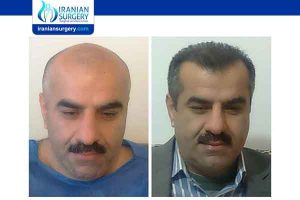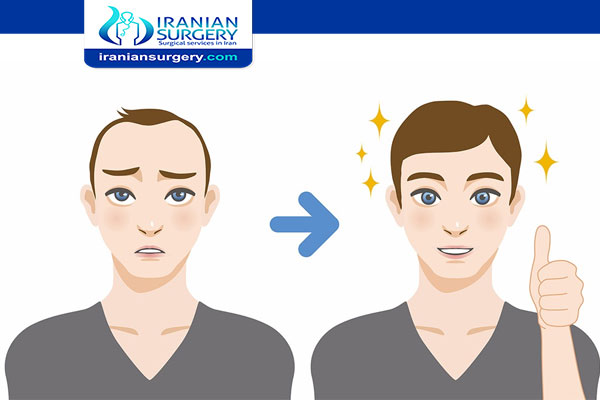Hair Transplant Risks and Side effects
What are the risks and Side effects of a hair transplant?
Like any surgery, a hair transplant involves certain risks. But with the right specialist by your side, they can be kept at the lowest level possible. In addition, the occurrence of adverse events after a hair transplant is considered to be relatively low compared to other surgical procedures. Here is an overview of the possible risks associated with a hair transplant.
Short-term Side effects
. Poor results
It may happen that the result does not meet your expectations. Either the hair density is too low or the hair grows in an unnatural direction and creates a non-aesthetic image. Failure to match the natural hair growth direction may also result in an unsatisfactory appearance. However, with a trained specialist who has been performing hair transplants for years, you need not be afraid of this risk.

. Pain during or after a hair transplant
Anaesthetic injections may be a bit uncomfortable as they need to be done at several points in the scalp. The use of needles and syringes may scare off some patients.
Moreover, the modern FUE method, which is almost exclusively used in hair transplantation now, is minimally invasive and done under local anaesthesia. Therefore, the patient will not feel any pain during the procedure.
. Inflammation and swelling
Of course, wounds can swell and redden after surgery. These risks of a hair transplant are bound to occur at least for a short time after the surgery has been performed. That is especially the case with the FUT method, where the doctor has to remove the whole strip of skin from the head. Inflammation can be disturbing for the patient, however, it is a normal consequence of any surgical intervention.
The tiny openings that occur during the FUE hair transplant usually heal without complications. Also, if the patient applies some antiseptic and soothing cream, inflammation and swelling will be relieved in 1-2 days. You can also reduce swelling by sleeping on a high pillow with your head elevated.
. Itching
Itching is quite common after surgery, it means that the wounds are in the process of healing. However, you must desist from scratching the itchy areas, since it can displace the newly implanted grafts as well as increase the risk of infection.
. Bleeding
Bleeding may occasionally occur within 2 weeks after the operation. To avoid or minimise it, the patient should never scratch the scalp or pick the scabs. Avoid strenuous physical activities, drinking alcohol, smoking, and taking aspirin within at least 7-10 days as well. If bleeding takes place, put a clean gauze cloth on the bleeding areas and gently apply pressure with your fingers.
. Infection
In the FUE method, the risk of infection is very low due to the less intrusive nature of the procedure. The doctor will most likely prescribe antibacterial cream to the patient to prevent any infection. However, keeping the hygienic standards is particularly important here, which is why it is necessary to check the reputation of the clinic beforehand.
. Scarring
Scarring may be quite visible if the patient has undergone the traditional FUT or ‘strip’ method. With the stitchless FUE method, you do not have to expect apparent scars. The visibility of scars, however, will also depend on how well the wounds can heal, if the scalp is loose or tight and how densely the surgeon implants the grafts.

Read more about: Hair transplant cost in Iran
Read more about: What should I do before hair transplant?
Long-term Side effects
While there are a number of short-term complications, these are often resolved within the first few weeks after the procedure takes place and the hair begins to grow back. However, there are some long-term complications which may also need to be considered:
. The grafts fall out
Some patients experience what's known as "shock loss," which causes all of the transplanted hair to fall out at once. However, it's very unlikely that this hair loss is permanent and typically new hair will grow in its place. This risk can be diminished by a comprehensive preoperative examination of the patient. It is possible to predict how good the grafts will take by assessing the quality of the scalp and hair.
. Scalp Laxity
The laxity of the scalp could be impacted after a hair transplant procedure, due to the trauma your head is put through during the surgery. This is most common after the FUT procedure. Typically, the scalp will regain the majority of its laxity within the first six-eight months after the procedure, but it will continue to loosen after this. If the patient had a loose scalp to begin with then the scalp is more likely to return to full laxity, while a tighter scalp prior to the surgery will see a more noticeable change.
. Hair Curl
A long-term complication after a hair transplant can be a ‘hair curl’. This means that the hair follicle which has been transplanted into the scalp has curled under which could result in an ingrown hair. This can be highly irritating for a patient and could result in infection. If there are a large number of curled hairs on the head, the results of the hair transplant may appear unnatural.
Read more about: Forehead reduction without surgery
Read more about: How long after hair transplant do you see results?
About Iranian Surgery
Iranian surgery is an online medical tourism platform where you can find the best hair transplant doctors in Iran. The price of a hair transplant in Iran can vary according to each individual’s case and will be determined based on photos, a number of grafts a patient needs and an in-person assessment with the doctor. It is our responsibility to give you enough information about this surgery, so that please feel free to contact us and get free consultation from Iranian surgery.
- Hair transplant in Iran
- Cost of hair transplant in Iran
- Hair transplant cost
- Hair transplant in Iran for female
- Pre-hair transplant in Iran
- Hair transplant recovery
- Follicular Unit Transplant (FUT) in Iran
- Follicular unit extraction (FUE)
- Can hair transplant fail
- Best hair transplant method
- Hair transplant in shiraz
- Hair transplant before and after
- Hair transplant surgery
- Beard transplant
- Is hair transplant permanent
- Hair transplant side effects
- Hair transplant without shaving
- Hair transplant growth
10 common question about hair transplant side effects
- Plastic surgery in Iran
- Rhinoplasty
- Liposuction
- Abdominoplasty (tummy tuck)
- Face lift
- Hair transplant for male
- Blepharoplasty
- Breast Augmentation
- Breast implant
- Breast Lift
- male breast reduction ( gynecomastia )
- Body sculpting
- Brazilian Butt Lift
- Facial plastic surgery
- Lip augmentation
- Ear pinning
- Neck lift surgery
- Chin lift surgery
- Arm Lift
- sex reassignment surgery ( sex change )
- Vaginoplasty
- labiaplasty
- Female hair transplant
- Reconstructive surgery
- Septoplasty
- Breast reconstruction
- Breast reduction
- Cleft lip and palate repair



